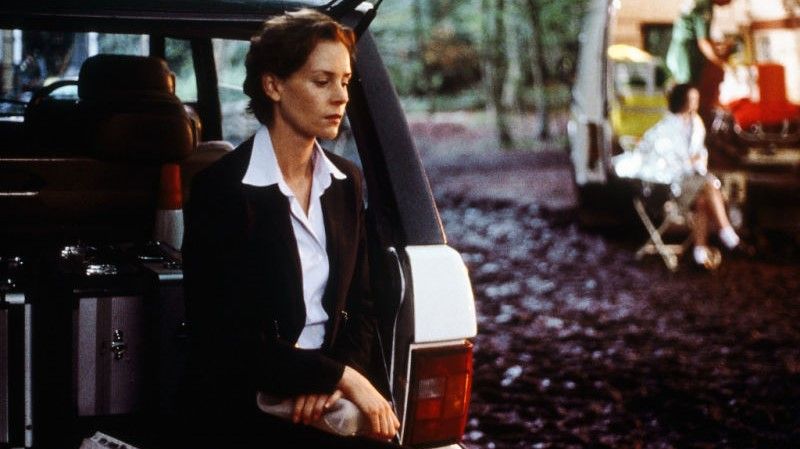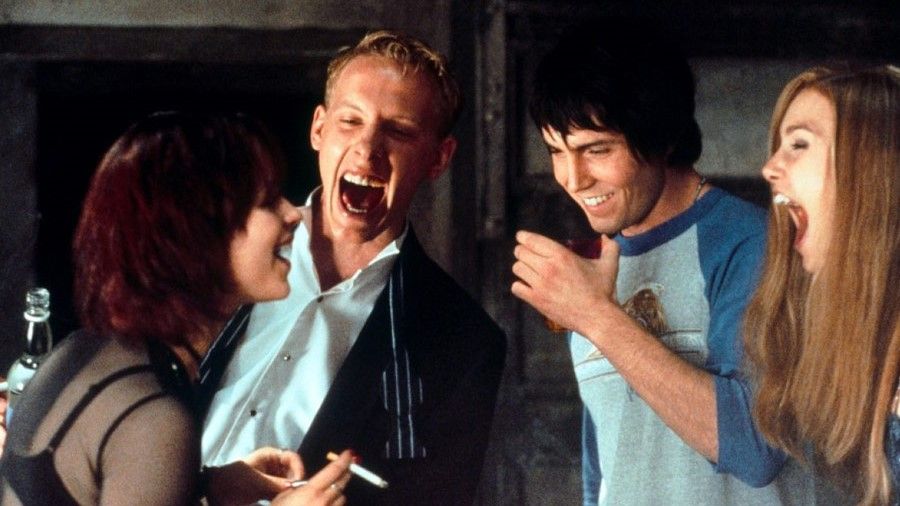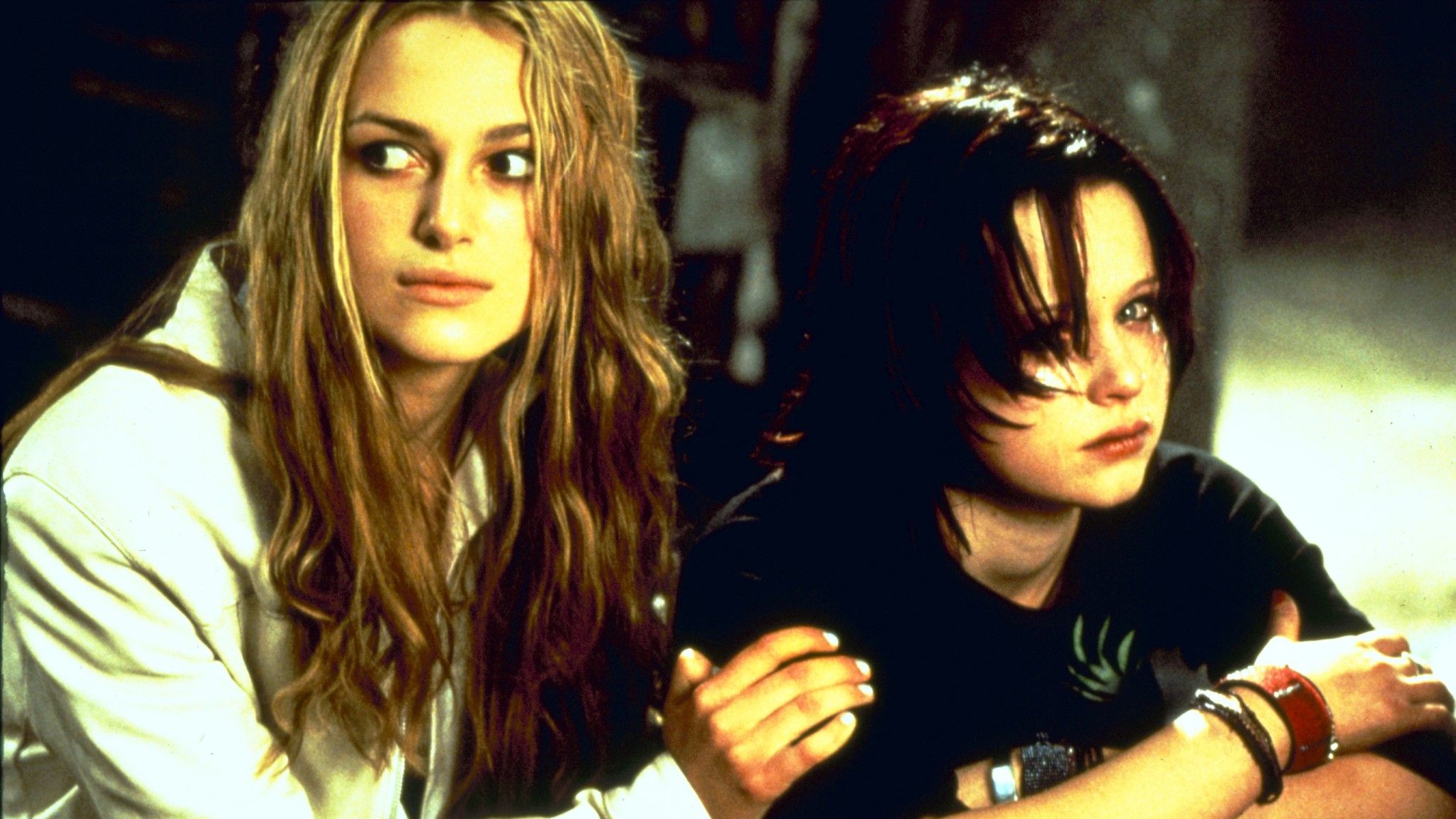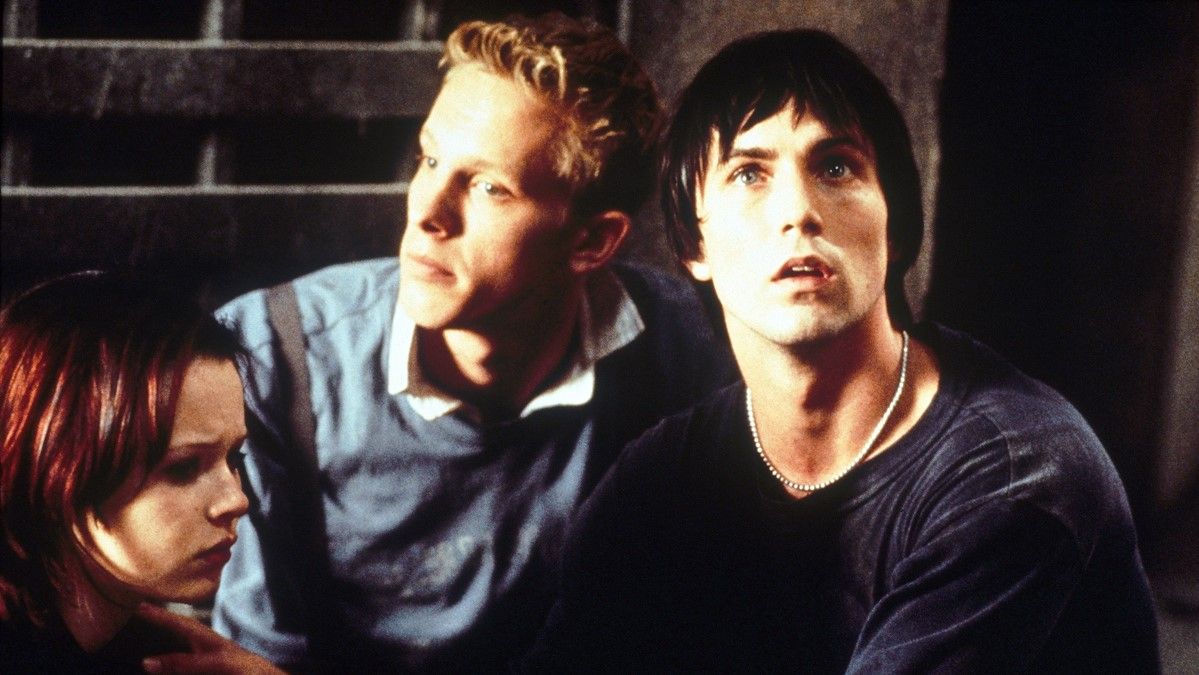When The Hole released in April 2001, it had a fairly limited theatrical run and garnered little attention. A British movie with a pretty modest budget, it earned its money back and basically sank without a trace for a number of years. But as time went on, it found a new audience with home video and television broadcasts. Indeed in this author’s own experience, it was recommended by a family member, and identified by asking a Blockbuster employee, “What’s that movie where the kids get trapped in the nuclear bunker?” When viewers paid attention to it, they found a cool, slick little thriller with a compelling mystery and strong performances from many recognizable faces.
The movie opens with a girl, Liz (Thora Birch), bloodied and dazed, staggering through a deserted village and calling for help. Police descend on the place, and the girl is brought to a psychiatric facility. She and three classmates have been missing for several weeks. It is the job of Dr. Horwood (Embeth Davidtz) to assess Liz’s state of mind, and try to figure out what happened. As the doctor gains her trust, Liz begins to tell her what happened, and these chunks of the story are told in flashback. From here, the action switches back and forth between present and alternative versions of the past.
Liz is the smart outcast at her private boarding school, whose only friend Martin (Daniel Brocklebank) is the fixer on campus, the one who can source contraband and organize clandestine escapades. From the wings, Liz pines after Mike Steel (Desmond Harrington), the sexy son of a rock star and epitome of early 2000s bad boy. Martin proposes that he put together an alternative field trip, in which Liz can get to know Mike, and hopefully get him to fall in love with her. Mike and his two popular friends Geoff (Laurence Fox) and Frankie (Keira Knightley) prepare to sneak off to an abandoned nuclear bunker to avoid an upcoming camping trip, and Martin adds Liz to the roster as payment for his location scouting services. To preserve the secrecy of this bunker, Martin locks the gang in, with the plan to return in a few days to let them out again. That’s the plan…
However, the allotted three days pass, and no one comes to let them out. Certain that Martin has done this deliberately because he is jealous of Liz’s feelings for Mike and that he is monitoring them, they start trying to think of ways to convince Martin to let them out. Thankfully, one of these proves successful, the door opens, and “here we are,” Liz explains. The doctor is perplexed, but Martin is arrested as a prime suspect, and questioned. That’s when things start to get weird.
Martin presents a very different sequence of events. He disdainfully talks the detectives through an alternative reality, in which Liz and Frankie are best friends and resident mean girls, who strut around their pink feathery dorms in fancy lingerie and smoke cigarettes. The latest sixth form intel reaches Frankie through her tragically millennial flip phone, announcing that Mike has been dumped by his hot girlfriend and is back on the market, prompting Liz to organize an alternative field trip of her own with the sole purpose of seducing him. This other side to the story is presented as a visual parallel to the earlier version, down to the opening words, “This is how it works at Brabourne.” Liz recruits Martin for his prowess as the underground Dr. Feelgood, and she masterminds a weekend-long rave in the bunker. Not only does he not have feelings for her, he barely knows her, and has no real motive for causing this whole ordeal. Things start to unravel.
After Martin and Liz get into an altercation over her blaming it all on him, the doctor comes to interview Liz again, who seems frantic and insists on being taken back to the bunker in the hopes of unlocking memories of what happened down there, which have apparently been clouded by trauma. The doc agrees with some uncertainty, and once down there, Liz begins to retell the story, and it’s very different from her first version. The weekend-long rave went down, she successfully hooked up with Mike, and Frankie with Geoff, and they spent the whole time getting high and screwing. However, when they couldn’t get out, things quickly spiraled out of control, and now it transpires, the other three died down there — something Dr Horwood knew the whole time. So what really happened?
By flipping back and forth between the present and varying versions of the past, the movie keeps you on your toes from start to chilling finish. The brilliant script by Caroline Ip and Ben Court is paced in the tradition of Ira Levin novels like Rosemary’s Baby and The Boys From Brazil: there is a mystery to solve, and audience attention is hooked by the strategic drip-feeding of new information, which allows the characters’ thought processes to move along organically. First it was a mean trick by Martin but all of them made it out alive and unharmed; then it became something instigated by Liz but presumably carried out by Martin. Now he fears he will go down for something he insists he didn’t do, but really, his version of events make a lot more sense than Liz’s, especially given that she didn’t even acknowledge the deaths of the other three. As the natural flow of the story draws more suspicion to Liz, it becomes increasingly and uncomfortably apparent that she knows everything.
Desperate to know the truth but clever enough to just be quiet and let Liz talk, the doctor wants to know how the others died. A longtime bulimic, Frankie contracts some kind of illness that causes extreme vomiting, and is found dead of heart failure. The others are incensed with fear and panic, but are unable to do anything, and live out the next days with her corpse decaying under a tarp. During this time, they all start to succumb to dehydration and starvation, but the peril brings Liz and Mike together, and they do actually seem to start falling in love. Things get more desperate and the gang seem hauntingly sure that they will all die down there. So when Mike hears the unmistakable pop of Geoff opening a can of soda, he sees red, and bludgeons him to death for his betrayal. He quickly realizes what he has done and goes mad with guilt and grief, making him vulnerable and ripe for Liz’s picking. They have been bonded by trauma, and when he talks her out of a suicide pact and tells her he loves her, Liz decides that her little experiment has gone far enough.
She opens the door. You see, she had the key all along. Not only did her actions lead to the deaths of her friends, but even that was not enough to shake her loose of her madness. She could have stopped any time. She could have stopped when she first hooked up with Mike, she could have stopped when Frankie got very sick. Or before they started to go delirious from dehydration. But she didn’t. She held the power the whole time, and she liked it, and ultimately it got her what she wanted. Or did it? There are still three bodies in the morgue. Well, as one might expect, Mike does not take kindly to this revelation. In fact, he is animalistic with rage, and throws himself up the bunker’s rickety metal ladder towards Liz, which breaks. He falls and is impaled by the rusty leg of the ladder upon impact. This is the only death that Liz shows even a glimpse of sorrow or remorse for.
Dr. Horwood is stunned. Stiffly, she insists that Liz retell this entire story to the police with a lawyer and her parents present. Liz refuses, and denies responsibility, saying that it was simply an innocent situation that got out of hand. Just then, one of Horwood’s colleagues and some police officers arrive on the scene, and Liz starts screaming, feigning an attack by the doctor. We learn that Martin’s body has been fished from the river in an apparent suicide, giving the police all the confirmation they wanted that he had been the culprit — and now the outcome of his altercation with Liz becomes clear. The closing sequence sees Liz in the back of an ambulance, Dr. Horwood standing nearby, and cuts between the two staring at each other. The pulsating music heightens, and a brief smirk crosses Liz’s face. She knows she has gotten away with it, she has effectively taunted the doctor with the truth, and now has turned the tables to reframe Horwood as the villain.
It is such a dark, impactful ending that truly chills the blood. The idea that your peer, someone you know well in everyday life, could have the capacity to cause your death out of what is essentially greed or selfishness is startling; the idea that such a person could get away with causing that death and feel no remorse is horrifying. The ending draws attention to what lurks beneath the surface. Just as an entire military bunker lies directly beneath an unassuming patch of forest, a dark, complex dungeon of its own kind exists within Liz.
Based on the novel After The Hole by Guy Burt, The Hole is the first of several collaborations between Ip and Court, who went on to create Whitechapel. Ahead of their success in murder mystery TV, The Hole shows their skill in crafting suspense. Irish director Nick Hamm, who started out in the Royal Shakespeare Company, was just a few titles into his film career, and had largely done comedy up to this point. He uses his theatrical background to bring style and mood to the movie, with the help of cinematographer Denis Crossan, whose experience in both young adult and horror guides the dark moody atmosphere. A frantic, fragmented visual style communicates the unreliability of recalled events — or recrafted narratives — and the frenetic energy of teenage life.
The Hole happened at an interesting time for most of its stars. Child star Thora Birch was hot off the awards darling American Beauty and looking to establish herself as an adult actor. Keira Knightley was just getting started, and within a year was gaining worldwide recognition in Bend It Like Beckham before being catapulted to stardom with Pirates of the Caribbean: The Curse of the Black Pearl. Embeth Davidtz was already well known with the likes of Matilda and Schindler’s List under her belt. Desmond Harrington would see success in a string of horrors, notably Ghost Ship and Wrong Turn. The four young leads have good chemistry together and show a good range, through swagger and bravado, fun and banter, panic, fear and rage. Although Thora Birch’s accent is a little too posh at times, she is a strong lead and continues to show that there is much going on behind even her blankest of expressions.
As a teenager, I found this movie engaging on many levels, and as a horror fan, I always enjoyed movies that could provoke a physical reaction, a chill up the spine or the rush of adrenaline, and the ending of The Hole really packed a punch in this regard. I also found it very relatable as a young person who fancied themselves as edgy and kind of rebellious: teenagers sneaking around doing all the stuff they weren’t supposed to, stylishly presented with a visceral energy and brooding quality… it was right up my street. It is a movie I still find engaging and exciting, and at times funny and heartbreaking, no matter how many times I have seen it. It is truly a favorite, and one I hope will continue to attract new viewers and new appreciation in the future.
"filled" - Google News
May 14, 2022 at 09:30PM
https://ift.tt/ydRlCwf
The Hole Is a Nearly Forgotten Suspense-Filled Thriller - Collider
"filled" - Google News
https://ift.tt/MrugyT5
https://ift.tt/Un0jAE6
Bagikan Berita Ini



















0 Response to "The Hole Is a Nearly Forgotten Suspense-Filled Thriller - Collider"
Post a Comment